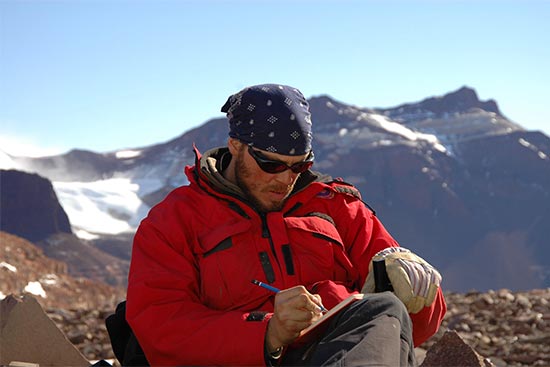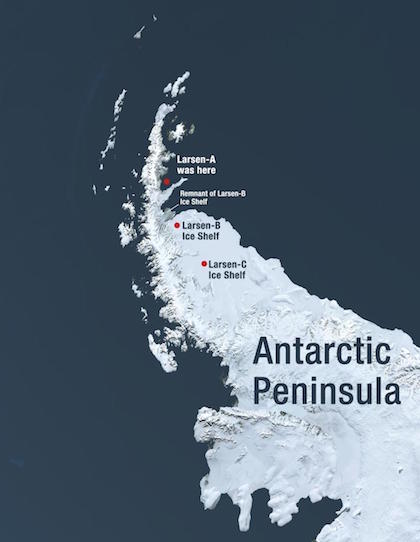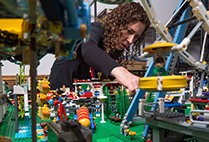Sometime between July 10 and July 12, an iceberg the size of Delaware broke off from Antarctica’s Larsen C ice shelf and floated into the sea. This isn’t the first time that a chunk of the Larsen shelf has severed, and it may not even be the biggest iceberg ever, but the massive break, and dramatic photos of the 120-mile-long crack that formed it, has captured the public’s imagination and made headlines worldwide. The event appears to many to be an awesome—and terrifying—warning of climate change.
Sean Mackay (GRS’15), a College of Arts & Sciences postdoctoral research associate and a member of BU’s Antarctic Research Group, has an intimate relationship with Antarctica and its ice, having traveled to the continent six times over the past nine years to collect information on ancient climate change from buried glaciers and other sources of old ice. He spoke to Bostonia about what the iceberg calving could mean for the future, and what role it might play in rising sea levels. “Sometimes it takes the giant events to get people’s attention,” he says.
The interview has been condensed and edited for clarity.

“It’s not hyperbole to say that some maps of Antarctica will need to be redrawn,” says glaciologist Sean Mackay, a member of BU’s Antarctic Research Group. Photo by David Marchant
Bostonia: What happens to the iceberg now? Is it going to float up to Boston?
Mackay: We don’t really know for sure, but Antarctica has this huge circumpolar sea current, and if the iceberg can reach that current, it will most likely break up into smaller chunks and start flowing north and east. Some estimates say it could reach the Falkland Islands. But when I say it, I mean a piece of it, not the whole shebang. So it’s not going to float up to North America.
So why does it matter if a piece of Antarctica breaks off? Will the iceberg contribute to sea-level rise?
Ice shelves are floating. That’s the definition of an ice shelf: it’s floating on the ocean. So the ice shelf itself, whether or not it’s attached to the Antarctic Peninsula, won’t contribute to any kind of sea-level rise.
The reason ice shelves are significant, though, is because they form, essentially, a cork that helps stem the outward flow of ice from the inland areas. And the Antarctic continent holds a huge amount of equivalent sea-level rise in the form of frozen fresh water, so when these ice shelves start to disintegrate, and especially if they disintegrate beyond kind of a point of no return, then those glaciers can flow more easily. And from the previous collapse of the Larsen A and the Larsen B ice shelves, we’ve been able to see firsthand—and directly measure—how quickly the upstream glaciers have accelerated. And it’s a lot. It’s up to three to five times faster.
And that increased flow would contribute to sea-level rise?
Yes. Once the grounded ice that’s above sea level starts flowing and accelerating and getting into the global inventory of seawater, then it absolutely contributes to sea-level rise. To put it in perspective, if all of the glaciers situated above the entire Larsen ice shelf were to flow down into the ocean, we’re looking at maybe 8 to 10 centimeters of sea-level rise, if it were all to flow down and disintegrate. But that’s if the entire ice shelf and the glaciers above it were to disintegrate. Nobody is saying right now that that’s imminent.
It’s not imminent, but it could potentially happen?

The July 2017 iceberg broke off from the Larsen C ice shelf. Portions of Larsen A and B ice shelves have previously collapsed. Antarctica holds a huge amount of frozen fresh water. Collapsing ice shelves allow inland glaciers to flow more easily. Photo courtesy of NASA
Yes, for sure. One of the things that’s significant about this current event is that it’s a huge chunk of ice. We’re not talking about a little iceberg that just popped off and bobbed away. It’s 12 percent or so of the entire Larsen ice shelf. And the question is whether or not this may destabilize the entire system, so suddenly the entire ice shelf becomes more dynamic and may undergo a rapid disintegration. But then again, it may not. We still don’t know whether this particular area is going to regrow or whether it will start to disintegrate.
Ted Scambos, who’s a glaciologist from the National Snow & Ice Data Center at the University of Colorado Boulder, characterized it as suspicious, and I think that’s reasonable. And what I mean by suspicious is that when you put it in context with the other changes that have been going on in the region, then it looks like this could be a harbinger of larger change to come.
The Antarctic peninsula as a whole has warmed significantly, and a lot faster than other parts of Earth, except maybe some parts of the Arctic. Since 1950, we’re looking at like 3 degrees C (so maybe 4.5 degrees F) of temperature increase. Although this warming trend has recently slowed, likely due to changes in regional wind patterns, this is still a lot. And then we’ve got a succession of ice shelf collapses, starting in the northernmost area—the warmest—and then slowly working its way more and more south.
I know that scientists are reluctant to tie specific events to climate change. Do you feel confident saying that this iceberg is a result of climate change?
In the context of all the other things going on in the region, my gut feeling is that climate change certainly contributed to it. However, as you said, it is not possible to draw a direct connection between climate change and this exact, specific event. Ice shelves naturally shed ice from time to time. But yes, my gut tells me that something is up.
You have a personal relationship with Antarctica and also a stake in it as a scientist. How does this event make you feel?
It’s almost theatrical, right? As a human, I see an event like this and it’s awe-inspiring and beautiful and fascinating to watch. It’s a huge symbol—the breakup of ice—that is connected to all kinds of other social and global issues that we’re facing these days. But then I have to temper that by recognizing that things happen on time scales that are not always easy to grasp as human beings and that this could be a once-every-so-many-thousand-year event that occurs, and then the ice shelf replenishes itself. My gut feeling is that it’s not, that it is a harbinger of more changes to come. But it’s just simply too difficult for me to make a call right now.
And what about the penguins. Are there penguins on the chunk now, floating away? Separated, parent from child?
As far as I know, the penguins didn’t particularly like this ice shelf anyway. Penguins tend to like places where they can get in and out of water pretty easily, and there’s no known major penguin rookery on the ice shelf. So the penguins aren’t floating away. There are other threats on penguins, don’t get me wrong, but not this one.
















































Related Stories
University Announces Massive Wind Power Purchase
15-year buy is a key part of BU’s Climate Action Plan
What Do the New Blood Pressure Recommendations Mean?
Cardiologist Gary Balady: “People don’t move guidelines; science moves guidelines”
Building a Better Barometer
CAS prof leads a quest to quantify climate change
Post Your Comment